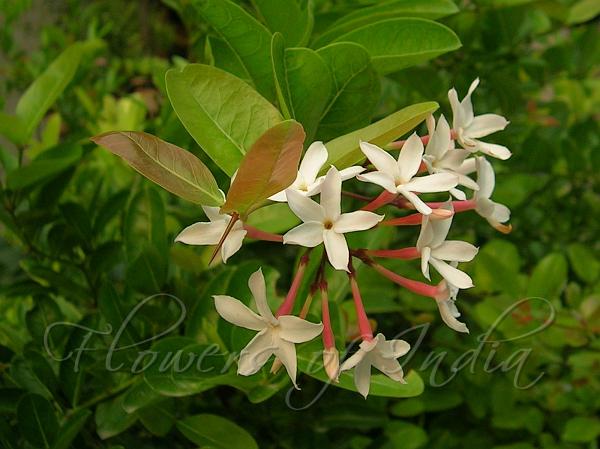|
| Karanda |
|

|

| File size | 224533 |
| Original date | 8/25/07 6:57 AM |
| Resolution | 2048 x 1536 |
| Flash | Flash did not fire, auto |
| Focal length | 5.4mm |
| Exposure time | 1/297s |
| Aperture | 2.8 |
| Focus Distance | |
| Metering Mode | Partial |
| Camera make | NIKON |
| Camera model | E3700 |
| Sensor type |
|
|
|
Photo: |
Botanical name: Carissa carandas Family: Apocynaceae (Oleander family)
Synonyms: Arduina carandas, Echites spinosus, Jasminonerium carandas
Synonyms: Arduina carandas, Echites spinosus, Jasminonerium carandas
The karanda is a sprawling semi-vine shrub native to India.
Leaves are from one-and-a-half to two-and-a-half inches long, very dark green,
shiny and opposite and they have large spines like many other Carissas. If the
leaves or stems are injured, the white milky sap is seen, which is
characteristic of this group of plants.
Although carissa karanda can be kept clipped into a shrub, it really prefers
to act much like a vine similar to bougainvillea and will climb to the tops of
rather tall trees. Small fragrant three-quarter-inch white flowers, with rose
stalk, are
produced from early spring through late fall and the clusters of small
purplish to black fruit ripen from May through October. Fruit size is
variable, but most fruits are about three-quarters of an inch in diameter with
a few seeds. Fruits usually occur in clusters somewhat resembling large purple
grapes. Fruit quality is excellent in this author's opinion, somewhat
resembling that of a blueberry in flavor. Fruits can be eaten fresh or used
for jellies or jam.
Medicinal uses: Its fruit is used in the ancient Indian herbal system of medicine,
Ayurvedic, to treat acidity, indigestion, fresh and infected wounds,
skin diseases, urinary disorders and diabetic ulcer,[8] as well as
biliousness, stomach pain, constipation, anemia, skin conditions. The
roots serve as a stomachic, an anthelmintic medicine for itches and also
as insect repellents.
Its fruit is used in the ancient Indian herbal system of medicine,
Ayurvedic, to treat acidity, indigestion, fresh and infected wounds,
skin diseases, urinary disorders and diabetic ulcer,[8] as well as
biliousness, stomach pain, constipation, anemia, skin conditions. The
roots serve as a stomachic, an anthelmintic medicine for itches and also
as insect repellents.
Medicinal uses:
 Its fruit is used in the ancient Indian herbal system of medicine,
Ayurvedic, to treat acidity, indigestion, fresh and infected wounds,
skin diseases, urinary disorders and diabetic ulcer,[8] as well as
biliousness, stomach pain, constipation, anemia, skin conditions. The
roots serve as a stomachic, an anthelmintic medicine for itches and also
as insect repellents.
Its fruit is used in the ancient Indian herbal system of medicine,
Ayurvedic, to treat acidity, indigestion, fresh and infected wounds,
skin diseases, urinary disorders and diabetic ulcer,[8] as well as
biliousness, stomach pain, constipation, anemia, skin conditions. The
roots serve as a stomachic, an anthelmintic medicine for itches and also
as insect repellents.| Identification credit: Neelima Kale, Navendu Pagé, Nandan Kalbag | Photographed in Delhi. |
• Is this flower misidentified? If yes,